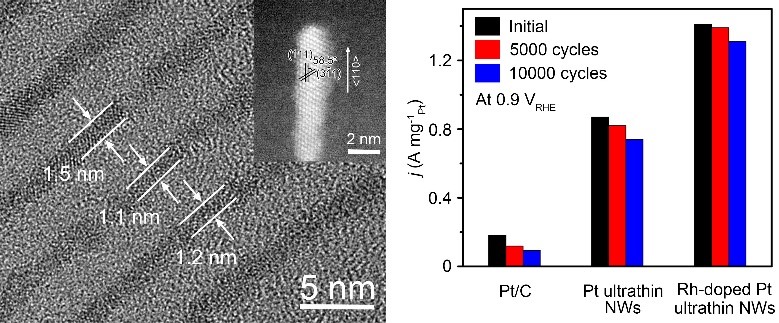Recently, the research group of Prof. Jie Zeng has made significant progress in the design of efficient nanocatalysts toward oxygen reduction reaction (ORR), a cathodic reaction of fuel cells, with the collaboration of Prof. Zhenmeng Peng from University of Akron and Prof Rui Si from Shanghai Institute of Applied Physics, Chinese Academy of Science. Researchers designed a new type of catalyst by combining the merits of high utilization efficiency of Pt atoms, anisotropic one-dimensional nanostructure, and doping of Rh atoms. This work was published on Journal of the American Chemical Society (J. Am. Chem. Soc. 2017, 139, 8152−8159), titling "Achieving Remarkable Activity and Durability toward Oxygen Reduction Reaction Based on Ultrathin Rh-Doped Pt Nanowires". Postdoctoral researcher Dr. Hongwen Huang and graduate student Li Kan contributed equally to this work.

Structure of Rh doped Pt nanowires and their catalytic performance in oxygen reduction reaction
Proton exchange membrane fuel cells (PEMFCs) have been recognized as a promising clean energy conversion technology for efficient power delivery in transportation and mobile devices. However, the commercialization of such technology has so far been hampered by the prohibitive cost of associated devices, because a large amount of precious platinum (Pt) is required as catalyst to mitigate the sluggish kinetics of the oxygen reduction reaction (ORR) at the cathode. One solution to lower the cost is to reduce the usage of Pt catalyst in PEMFCs by improving the mass activity toward ORR, besides, another method to improve the mass activity is to boost the specific activity of a catalyst. Although a number of Pt-based catalysts with excellent mass activities have been successfully reported, most of these catalysts suffered from the relatively mediocre durability. The insufficient durability of these Pt-based catalysts is ascribed to the thermodynamically unstable structures that are generally needed for high mass activities, so it seems that there is a conflict between high mass activity and superior durability.
Faced with the challenges, researchers designed and synthesized a remarkable Pt-based catalyst by combing the features of high utilization efficiency of Pt atoms, anisotropic one-dimensional nanostructure, and doping of Rh atoms. The mass activity and specific activities of the produced Rh-doped Pt nanowires are 7.8 and 5.4 times higher than that of commercial Pt/C catalyst, respectively. Moreover, even after 10,000 cycles of accelerated durability test in O2 condition, the Rh-doped Pt nanowires/C catalyst exhibits a drop of 9.2% in mass activity, against a big decrease of 72.3% for commercial Pt/C.
This work was supported by CAS, MOST of China, National Natural Science Foundation of China, and China Postdoctoral Science Foundation.
Source: http://pubs.acs.org/doi/abs/10.1021/jacs.7b01036

